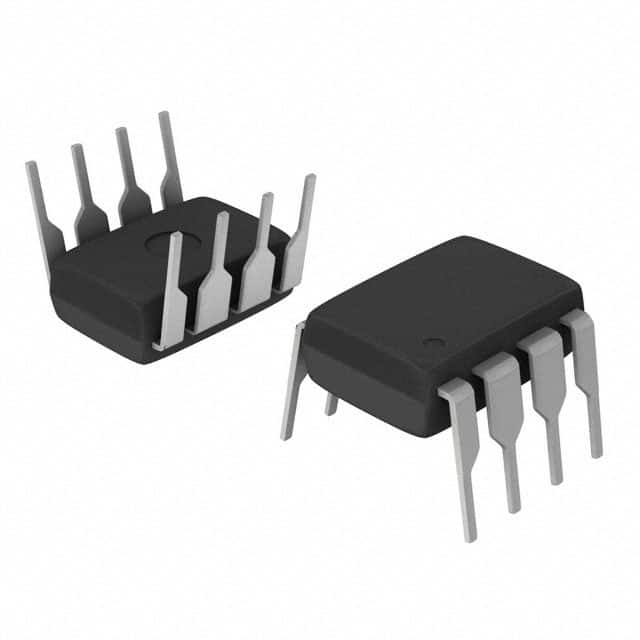LM2903SNG
Product Overview
Category: Integrated Circuits (ICs)
Use: LM2903SNG is a dual differential comparator designed for use in industrial, automotive, and consumer applications. It is commonly used in voltage level detection, signal conditioning, and analog-to-digital conversion circuits.
Characteristics: - Low input offset voltage - Wide supply voltage range - Low power consumption - High output sink current capability - Fast response time
Package: LM2903SNG is available in an 8-pin SOIC (Small Outline Integrated Circuit) package.
Essence: The essence of LM2903SNG lies in its ability to compare two input voltages and provide a digital output based on the comparison result.
Packaging/Quantity: LM2903SNG is typically sold in reels containing 2500 units per reel.
Specifications
- Input Offset Voltage: ±2 mV (maximum)
- Supply Voltage Range: 2 V to 36 V
- Input Common Mode Voltage Range: -0.3 V to Vcc + 1.5 V
- Output Sink Current: 20 mA (maximum)
- Response Time: 1.3 μs (typical)
Pin Configuration
LM2903SNG features an 8-pin SOIC package with the following pin configuration:
```
| | --|IN(-) IN(+)|-- --| |-- --|GND VCC|-- --| |-- --|OUT NC |-- --| |-- --|NC OUT|-- |___________| ```
Functional Features
- Dual differential inputs for comparing two voltages
- Open collector outputs for easy interfacing with other digital circuits
- Internal frequency compensation for stability
- Low input bias current for accurate measurements
- Wide operating temperature range (-40°C to +125°C)
Advantages and Disadvantages
Advantages: - Low input offset voltage ensures accurate comparison - Wide supply voltage range allows flexibility in various applications - Low power consumption for energy-efficient designs - High output sink current capability enables driving of external loads - Fast response time for real-time applications
Disadvantages: - Limited number of comparators (dual) in a single package - Lack of built-in hysteresis may require additional circuitry for noise immunity
Working Principles
LM2903SNG works based on the principle of comparing two input voltages. It amplifies the voltage difference between the inputs and provides a digital output based on the comparison result. The output is driven low when the voltage at the non-inverting input (+) is higher than the voltage at the inverting input (-), and vice versa.
Detailed Application Field Plans
LM2903SNG finds applications in various fields, including: 1. Voltage level detection circuits 2. Signal conditioning circuits 3. Analog-to-digital conversion circuits 4. Battery management systems 5. Motor control circuits 6. Sensor interfaces 7. Power supply monitoring circuits
Detailed and Complete Alternative Models
Some alternative models that can be considered as alternatives to LM2903SNG are: 1. LM393N 2. LM339N 3. LM311N 4. LM324N 5. TL331 6. MAX9117
These models offer similar functionality and can be used as drop-in replacements depending on specific requirements.
In conclusion, LM2903SNG is a versatile dual differential comparator with low input offset voltage, wide supply voltage range, and fast response time. Its compact SOIC package and various functional features make it suitable for a wide range of industrial, automotive, and consumer applications.
Lista 10 Vanliga frågor och svar relaterade till tillämpningen av LM2903SNG i tekniska lösningar
Sure! Here are 10 common questions and answers related to the application of LM2903SNG in technical solutions:
Q: What is LM2903SNG? A: LM2903SNG is a dual differential comparator integrated circuit (IC) commonly used in various electronic applications.
Q: What are the key features of LM2903SNG? A: Some key features of LM2903SNG include low input offset voltage, low input bias current, wide supply voltage range, and compatibility with TTL and CMOS logic.
Q: What is the typical operating voltage range for LM2903SNG? A: The typical operating voltage range for LM2903SNG is between 2V and 36V.
Q: How does LM2903SNG compare two input voltages? A: LM2903SNG compares the voltages at its two inputs and provides a high or low output depending on the result of the comparison.
Q: Can LM2903SNG be used as a voltage level detector? A: Yes, LM2903SNG can be used as a voltage level detector by setting a reference voltage at one input and comparing it with the input voltage at the other input.
Q: Is LM2903SNG suitable for battery-powered applications? A: Yes, LM2903SNG is suitable for battery-powered applications due to its low power consumption and wide supply voltage range.
Q: Can LM2903SNG be used in automotive applications? A: Yes, LM2903SNG is often used in automotive applications such as speed control, motor control, and battery management systems.
Q: Does LM2903SNG have built-in hysteresis? A: Yes, LM2903SNG has built-in hysteresis which helps in reducing output oscillations near the switching threshold.
Q: Can LM2903SNG be used in high-frequency applications? A: While LM2903SNG is not specifically designed for high-frequency applications, it can still be used in moderate frequency applications up to a few hundred kilohertz.
Q: Are there any recommended external components to use with LM2903SNG? A: It is recommended to use bypass capacitors at the power supply pins of LM2903SNG to improve stability and reduce noise interference.
Please note that these answers are general and may vary depending on specific application requirements.


